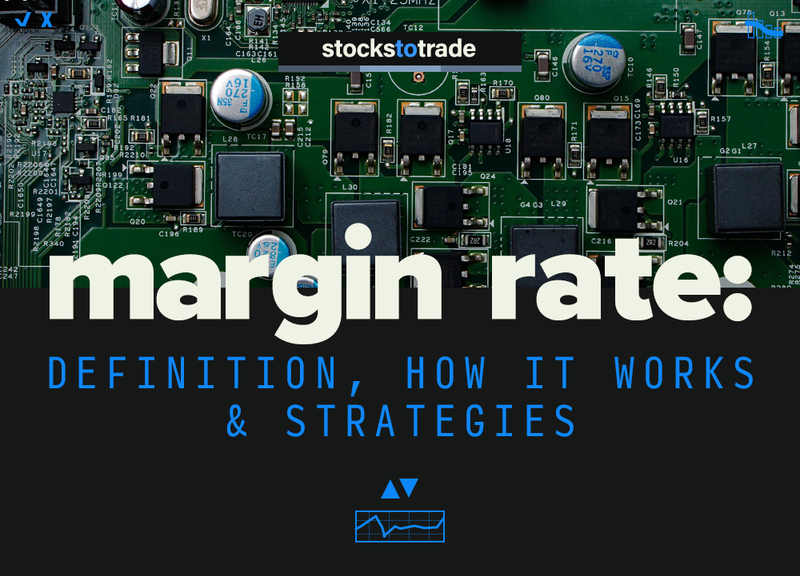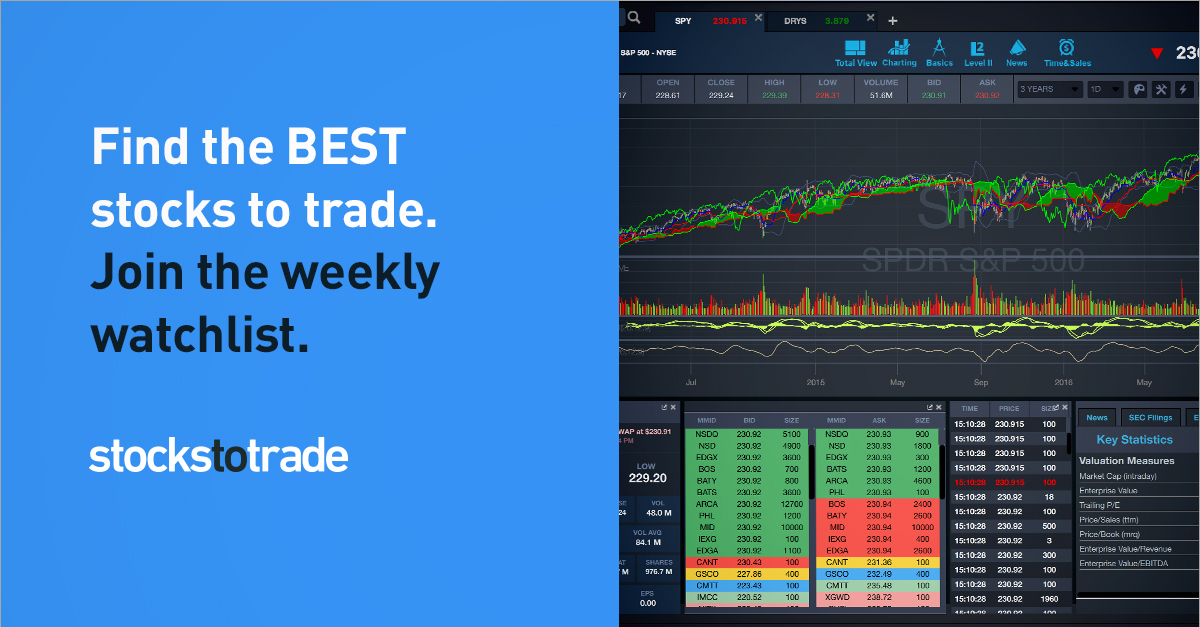Using leverage in trading might sound like a great idea — until you add up the margin rate and all the other fees.
You need to account for this stuff before you trade on margin. Otherwise, you might end up turning a successful trade into a bad one.
Factoring margin rate into your trades isn’t overly complicated. But it’s one of those things you may not pay enough attention to. That is, until you’re in a leveraged position longer than you planned.
That’s why I’m always going on about sticking to your trading plan!
That’s only gonna work if your trading plan covers all the bases.
Table of Contents
- 1 What Is Margin Rate?
- 2 How Margin Rates Affect Your Trading Style
- 3 Understanding Margin Rate: How Does It Work?
- 4 When Is Margin Interest Charged?
- 5 How Is Margin Interest Calculated?
- 6 Factors That Affect Margin Rate
- 7 Robinhood Margin Rates
- 8 TD Ameritrade Margin Rates
- 9 Why Are Margin Rates So High?
- 10 Buying on Margin: Is It a Good Idea?
- 11 Conclusion
What Is Margin Rate?
Margin rate is also known as margin interest. It’s one fee that you have to take into account whenever you make a trade on margin.
How Margin Rates Affect Your Trading Style
The impact of margin rate on a trade depends on the time frame.
If you’re a short-term trader, the interest due at the close of your trade might be minimal. But if you’re a long-term trader, it can become a more serious consideration.
If you’re hearing this for the first time, I’d advise you to slow down. Focus on your education. Taking a massive swing on a ‘can’t miss’ trade might seem like a good idea, but it’s not the way to become a consistent trader.
Sit in on my no-cost Pre-Market Prep sessions for starters. It’s where I break down what I like and don’t like about what I see in the market.
Trigger warning: I might talk about shorts getting crushed on trades fairly often. If you’ve just been winging it up to this point, I hope this gives you some pause.
Understanding Margin Rate: How Does It Work?
Margin rate is just one of the fees you have to pay attention to when you trade on margin.
There’s also the borrow rate — aka the stock loan fee. This rate varies much more than margin rate, depending on the borrowing demand. The borrow rate can even change over the course of the day.
These two costs shouldn’t be confused with the other percentages in margin trading…
When you first take out a margin loan, you need to have a minimum amount of equity in your account to borrow on. The Financial Industry Regulatory Authority (FINRA) sets this rate at 50%. You can borrow less than 50%, but you can’t borrow more.
Now let’s say your trade loses money. You can hold the position as long as you still have the maintenance requirement in your account. FINRA lists a minimum of 25% for this, but brokers will often make it somewhere from 30% to 40%.
This amount can vary by broker. Another reason to make sure your broker’s requirements fit your trading style.
Your broker can make a margin call if your equity falls below the maintenance requirement. This means you have to deposit more cash or securities into your account. They don’t have to issue a warning, though. When you take out a margin loan, you give your broker ultimate control of your trade.
These are the headlines on margin loans that you can’t miss. When we talk about margin rate, we’re talking about the additional fees that you might miss — up till they come due.
How Much Is Margin Interest?
The margin rate varies from brokerage to brokerage. But most of them build it in the same way.
They start out with a base lending rate. This rate is based on the broker call rate — the amount of interest a brokerage gets charged if they want to borrow money from another lender. They add a few percentage points to this number to get the base rate.
The base rate ensures that your broker won’t lose money issuing a margin loan. Most brokers will add or subtract percentage points depending on the amount borrowed.
This often breaks into tiers. The higher tiers of borrowing pay less interest. You’ll need to put up a relatively large amount of equity to qualify for anything higher than the bottom tiers.
What Is a Margin Rate on a Brokerage Account?
A margin rate is always the same as margin interest in a trading context.
When Is Margin Interest Charged?
With a long-term margin loan, interest is charged to the account on the last day of the month.
Margin rate is a different beast for short-term traders. You pay no interest on intraday margin loans repaid by 4 p.m. Eastern time. If you hold a margined position overnight, you’ll pay a prorated amount of the yearly interest.
How Is Margin Interest Calculated?
We’ve already talked about the base rate. This is the amount your broker will charge you on the principal of your margin loan over the course of a year.
You probably won’t be holding a margined position for a year. In fact, if that’s something you’re even considering, I’d suggest you revisit your trading plan.
The market tends to trend upward. This means that long-term shorts are fighting more than just mounting fees.
The margin rate calculations for short-term margin loans have a simple formula. Just take the margin interest rate and multiply it by the principal. This is your annual interest rate.
To get the daily rate, divide that number by 360 days.
Why use 360 instead of 365? The way the story goes is that, back in the day, traders used the 30 days per month average to simplify calculations. I’m sure it doesn’t hurt that the interest based on the smaller number is a little bit higher.
Now that you know your daily rate, you can figure out your margin interest by multiplying the number of days.
The formula looks like this:
Margin rate x Principal / 360 x Number of days = Total interest
Let’s use 2020’s margin rates at Schwab for our example. If we borrowed $10,000, we’d fall into the highest margin rate bracket. For loans up to $24,999.99, Schwab charges their base rate of 6.5% with an added 1.825%. The effective rate on our loan would be 8.325%.
Let’s say we wait 10 days before repaying the loan. This is how much we’d owe:
0.08325 x 10,000 / 360 x 10 = $23.13
Not exactly a backbreaker, but it’s not nothing either!
Factors That Affect Margin Rate
In the following sections, we’ll do a margin rates comparison for different brokers. Why do they vary so widely broker by broker?
Let’s talk about what goes into margin rate.
Broker Call Rate
This is the foundation of the margin interest rate that your broker will charge.
The broker call rate is the amount that the broker pays to its bank or financial institution. It’s based on the London Interbank Offered Rate (Libor), which is the basic interest rate used in loans between banks. The broker call rate will usually be a little higher than Libor, but not much.
Call Loans
Broker call rates are call loans. A call loan isn’t given for an agreed amount of time. Like a margin loan, it can be called back at any time. This helps to keep the rate low, as it guards against the opportunity cost that can come with lending money.
This feature also keeps margin interest low. Because a margin loan can be asked back at any time through a margin call, there’s little risk for the brokerage.
Brokerage’s Business Model
This is the biggest difference between margin rates on the lower end like Interactive Brokers’ and those on the higher end like Fidelity’s. Where does your brokerage make its money?
Your brokerage needs to make its profits somewhere. Interactive Brokers charges for some features that Fidelity doesn’t. Fidelity’s margin rates are a bit higher in the tradeoff.
This doesn’t mean one brokerage is better than the other. But it’s a good example of why you should always look around for the broker that works best for you.
There’s also the option that I personally use. That’s to connect your broker to a dedicated trading platform like StocksToTrade.
StocksToTrade has awesome charting abilities and a wide range of built-in stock scans. Its news scanner pulls in catalysts from all over the web. Add-ons like Level 2 data and curated alerts will kick your trading up a notch.
What you want from your broker is good executions and borrows. StocksToTrade can handle the rest. Try StocksToTrade for 14 days — it’s just $7.
Robinhood Margin Rates
Robinhood changed the trading game by offering commission-free trading to cost-conscious newbies. New traders often think that because they’re paying less for a trade, they’re getting a better deal.
Robinhood recently changed the game again. In December 2020, it cut margin rates from 5% to 2.5% for its premium customers. It even gives these customers the first $1,000 in margin interest-free.
But brokers make money somewhere. So do your research.
TD Ameritrade Margin Rates
TD Ameritrade sits at the other end of the margin rate spectrum. Like E-Trade, its margin rates start out around 9%. Compared with the lower rates of Robinhood and Interactive Brokers, this can seem like a bad deal. It isn’t necessarily.
I don’t want to harp on this too much, but margin rates and other fees shouldn’t be the first thing you look at in a broker. If you’re trading on margin, look at the available borrows. Try a broker and see how you like them.
You should be looking at your trading style and the kinds of trades you want to make.
If you haven’t figured this out yet, concentrate on studying. We have a ton of articles at StocksToTrade to help you figure out the basics.
For the more advanced stuff, give our SteadyTrade community a look. We’ve got experienced mentors guiding you through webinars and trading plan advice.
Fees like margin rate should be the fine print of your trading plan. They shouldn’t be the reason you consider a trade in the first place.
Why Are Margin Rates So High?
You might be staying in margined trades for too long. Remember, the market will ultimately trend up. Even sketchy stocks can stay up in a good market.
Make sure you have a good trading plan in place before trading on margin. And make sure your exit plan is realistic.
Buying on Margin: Is It a Good Idea?
The same cautions apply if you’re using margin as leverage to go long. It can work to your advantage. But be aware that you can lose more than you put in.
Conclusion
Margin rates are kind of like that neighborhood dog that’s all bark and no bite. But tiny nips can still hurt … especially if a bigger dog is biting you at the same time!
A good trading plan considers these factors. That’s really the thing I hope you got from this article. Thinking through this stuff in advance will save you the pain of getting it wrong.
Luckily, you don’t have to go it alone. Check out the SteadyTrade Team if you’re looking for mentorship and an awesome trading community of people who love the markets and finding their own way.
Is margin rate a big factor in your trades? Have you had a winning trade turn into a loss because of interest? Let me know in the comments!



